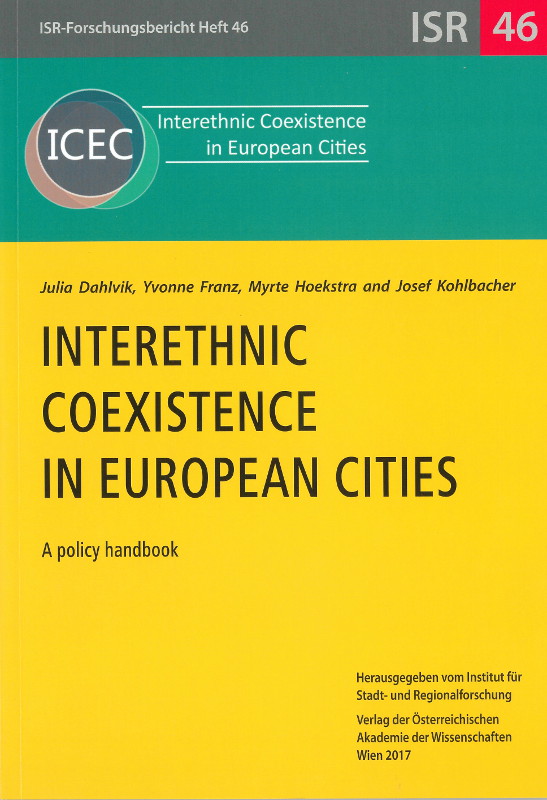 |
 |
DAHLVIK Julia - FRANZ Yvonne - HOEKSTRA Myrte - KOHLBACHER Josef
Interethnic Coexistence in European Cities
A policy handbook
Julia Dahlvik,
Yvonne Franz,
Myrte Hoekstra,
Josef Kohlbacher
S. 76 - 85 doi: 10.1553/ISR_FB046s76
Verlag der Österreichischen Akademie der Wissenschaften doi: 10.1553/ISR_FB046s76
Abstract:
Das letzte vorliegende Kapitel widmet sich einer speziellen, aber dafür umso innovativeren Thematik. Es werden, ausgehend von der seit Mitte der 2000er-Jahre auch die Sozialwissenschaften stimulierenden Living-Lab-Konzeption, die Effekte von Urban Living Labs und „ungeplanter“ Begegnungsräume auf interethnische Kontakte untersucht. Die Analyse basiert methodisch auf halbstrukturierten Interviews und teilnehmenden Beobachtungen in drei Urban Living Labs in Wien, nämlich dem Nachbarschaftszentrum in Gumpendorf, dem Nachbarschaftsraum „Herbststraße 15“ sowie dem Urban-Gardening-Projekt „Matznergarten“ im 14. Wiener Gemeindebezirk. Es wird untersucht, ob und in welcher Weise sich interethnische Begegnungen in den drei Living Labs unterscheiden von anderen institutionalisierten Räumen und welche Konsequenzen dies für die BewohnerInnen und die politischen Entscheidungsträger hat. In der vorliegenden Untersuchung bildete eine Konzeption des Social Urban Living Labs mit ausgeprägten Elementen der Kokreation, die auf einem explorativen Umfeld basiert, den Ansatzpunkt. Die komparative Analyse zeigt, dass der Erfolg einer Initiative vor allem abhängt von der Zahl ihrer TeilnehmerInnen, ihrer Kontinuität und dem Grad interethnischer Begegnung. Nur in relativ wenigen Initiativen kann wirklich eine Durchmischung von nichtösterreichischen und österreichischen TeilnehmerInnen beobachtet werden. Dies hängt mit inkludierenden beziehungsweise exkludierenden Effekten der untersuchten Maßnahmen zusammen, wobei die Ausschließungsmechanismen keineswegs nur ethnisch, sondern auch sozioökonomisch zu verstehen sind. Als Ergebnis ist festzuhalten, dass Kontext und Design einer Initiative sowie deren Grad der Institutionalisierung die Art der Begegnung und somit auch die Erfahrungen der BewohnerInnen mit ihrem Wohnumfeld beeinflussen. TeilnehmerInnen an Initiativen versuchen häufig, eine Balance zu finden zwischen Behaglichkeit und Informalität einerseits sowie Inklusivität und Offenheit andererseits. Es ist daher möglich, dass ein und dieselbe Initiative bei unterschiedlichen Personen sowohl ein Gefühl der Zugehörigkeit als auch Gefühle der Exklusion erzeugt. Die Resultate der vergleichenden Untersuchung zeigen, dass TeilnehmerInnen nicht notwendigerweise auf der Suche nach sehr engen Sozialkontakten sind. Es ist daher wichtig, die Rolle fließender und unverbindlicher sozialer Interaktionen hervorzuheben und diese entsprechend zu fördern. BewohnerInnen bevorzugen häufig oberflächliche Begegnungen und die persönlichen Motivationen für die Teilnahme an Initiativen finden sich nicht selten in dem Versuch, persönliche Lebensumstände zu verbessern. Differenzierte Bedürfnisse von Zielgruppen sind vor allem hinsichtlich der Inklusivität bzw. Exklusivität von Maßnahmen und Aktivitäten zu berücksichtigen, wobei der Typus von Initiativen ebenfalls eine erhebliche Rolle spielt. Bottom-up-Initativen sind eher geeignet Mitverantwortlichkeit und letztlich lokale Teilhabe zu fördern. Urban Living Labs sind in der Lage mehr interethnische Sozialkontakte zu fördern, solange kokreative Settings von Rahmenbedingungen zwischen InitiatorInnen, BewohnerInnen und ForscherInnen gewährleistet sind. Kokreation ist ein wichtiges Ergebnis interethnischer Begegnungen in Living Labs, welches die Offenheit der InitiatorInnen voraussetzt, die Bedüfnisse und Forschungsinteressen entsprechend einzubinden und aufeinander abzustimmen. In diesem Fall kann Forschung also auch als ein Korrektiv für Integrationspolitiken dienen, welche eigentlich auf Inklusion gerichtet sind, jedoch unintendierte Exklusionsmechanismen beinhalten.
2017/11/08 13:34:22 Object Identifier:
0xc1aa5576 0x003709f3
Rights:All rights reserved.For questions regarding copyright and copies please contact us by email.
This policy handbook discusses the policy-relevant results of the JPI Urban
Europe project “Interethnic Coexistence in European Cities” (ICEC). A more detailed
documentation of the research approach, methodology and local results on Amsterdam,
Stockholm and Vienna can be found in various publications available for download
from www.icecproject.com
There is not one specific mode of interethnic coexistence – neither in the
same city nor in the same neighbourhood. This is one remarkable fact uncovered by
the authors of this report during their intensive field research. Interethnic coexistence
works in many different ways and is extremely diverse. In our interviews, coexistence,
for example in Vienna, generated such polarised messages as “[…] they have their
own communities, where they meet and don’t want to have contact with us”, but also
this statement of an Austrian lady: “With Turkish residents one gets a different kind
of contact, as there is immediate understanding and openness [...]”. The quality of
coexistence and the quantity of interethnic interaction are as heterogeneous as the case
study neighbourhoods and individuals with whom we spoke. Patterns of interethnic
relations are clearly marked by the social and economic status of the neighbourhoods,
but are also influenced to a lesser degree by the proportion of the migrant population
and the ethnic mix.
The ICEC project compared neighbourhood initiatives in Amsterdam, Stockholm
and Vienna and considers their effect on local interethnic coexistence and neighbourhood
belonging. The study focused on three core questions:
1. Which local initiatives best support and strengthen the integrative power of urban
neighbourhoods as places of living and identification for an ethnically diverse
population?
2. How does participation in such local initiatives and the initiatives themselves
impact the neighbourhood belonging of local residents?
3. What kinds of differences can be found between (non)participation in top-down
and bottom-up initiatives?
|




 Home
Home
 Print
Print
 References
References
 Share
Share
